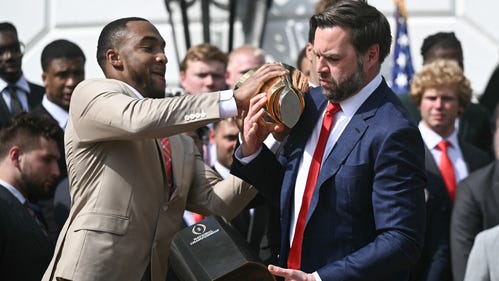
JD Vance fumbles Ohio State title trophy at White House event
Ryan Day and the Ohio State Buckeye’s football team were honored at the White House for their 2024 national championship victory.
These problems aren’t unique, everyone. They’re just constantly viewed at surface level.
The latest rage is this: the NFL Draft needs an opt out clause. If you don’t like where you’re drafted, you can go back to college football.
This, of course, is ludicrous.
But when Texas quarterback Quinn Ewers is selected in the seventh round, or Alabama quarterback Jalen Milroe – invited to the draft by the league – had to wait until the third round to be selected, maybe someone, somewhere is giving players bad information.
Or maybe they just wanted out of college football.
Years ago, I had a long conversation with then-UCLA quarterback Josh Rosen. Say what you want about his NFL flop, he was one of the rare, elite college players who saw beyond the surface — and wasn’t afraid to speak his mind.
Long before player empowerment was a thing, long before the NCAA caved in 2021 on NIL and free player movement to avoid losing the billions it eventually will under the House case and ensuing revenue sharing, Rosen was talking about finding a compromise.
One of his key points: many players leave after their junior seasons – no matter their grade from the NFL Draft advisory board – because school is simply not for them.
It doesn’t mean they can’t handle the academic workload or a suddenly unique public life, it just means they’re more comfortable in a professional environment where their entire focus is football.
It is here where we introduce the late, great Mike Leach, who had a whopper of plan a couple of years ago that was scoffed and laughed at — and now, in these ever-changing days of the sport, looks incredibly insightful.
A year after the NCAA threw open the barn doors on NIL and free player movement, Leach explained to me an idea he had for optional learning tracks for football players at major universities.
“We can ignore the reality of the situation, or we can face it and do something about it,” Leach said.
This from the guy who had a plaque in his office – at Texas Tech, Washington State and Mississippi State – that read, “You’re either coaching it, or allowing it.”
For far too long, the NCAA has been allowing it.
Leach’s plan is simple: there are two academic tracks for football players at major universities. When a high school recruit signs a letter of intent, he chooses the specific academic track — student athlete, or learning professional.
Leach estimated then that the student athlete track (the current academic model) is for about about 90 percent of players. That was before the explosion of NIL and projected revenue sharing.
The student athlete number may have drastically decreased since.
The student athlete track consists of the current benefits and a stipend, which would now be revenue share. Players can’t be cut for playing ability, but can be cut for breaking rules. No trades, no draft.
But there’s a sweet, sweet carrot dangling out there: if players graduate in four years, and play all four seasons of eligibility at the same school, they receive a significant retention bonus.
If players transfer at any time, or don’t graduate, they’re ineligible for the retention bonus.
“I don’t like taking the degree out of the equation,” Leach said. “Degrees help lives, help families, help generations.”
Then there’s the learning professional track, the group of players Leach said more closely align with the current explosion of NIL and player movement.
It begins with a deadline for high school players to declare the learning professional track, and once it passes, there will be a draft. That’s right, a draft.
“Every other league does it,” Leach said. “The crummiest sports league or the best, they draft. Little league has a draft.”
And that’s part of the gamble for young players. If you enter the learning professional track, you can be drafted by any school.
You aren’t choosing your school, they’re choosing you. This brilliant move also brings parity into the equation.
Another unintended, yet wildly positive, consequence of Leach’s plan.
“There’s no bargaining and extorting (NIL) money from schools, playing one against the other,” Leach said. “Like hell, you will. Not here. We’ll call you when you’re drafted, and you’ll know what team you’re playing for.”
There’s no cap on NIL money, and a player can make whatever the market will bear. Players can be cut at any time for any reason, just like the NFL. Players can be traded.
Players can move freely between schools annually, but within a one-week window after the season.
The learning professional track will include academic courses that directly affect individual growth. Finance and investing, kinesiology, psychology, and the like.
“Everyone wants guardrails to this deal,” Leach said. “Well, here they are.”
For decade upon decade, the NCAA has been a reactionary body. Never leading, always reacting to the latest lawsuit ― and losing nearly every single time in every single major lawsuit involving player vs. university.
The NCAA isn’t coaching it, it’s allowing all of this unraveling of the sport to go unchecked.
Maybe it’s time to change course.
Matt Hayes is the senior national college football writer for USA TODAY Sports Network. Follow him on X at @MattHayesCFB.
This post was originally published on this site be sure to check out more of their content.



